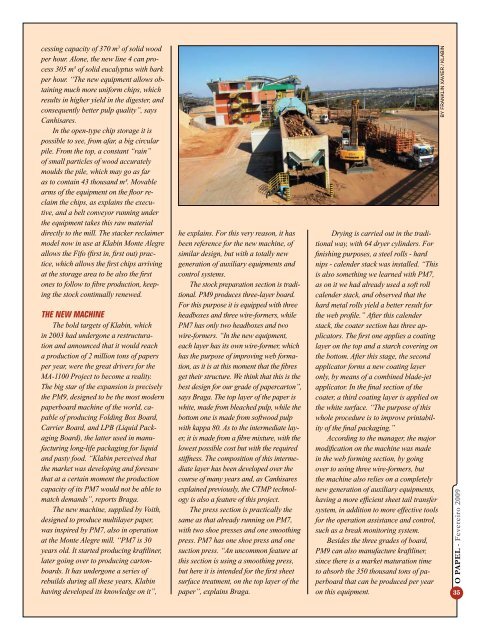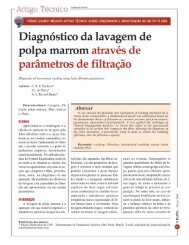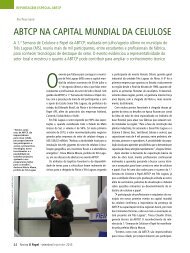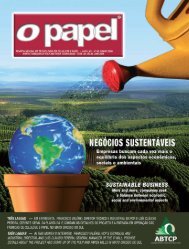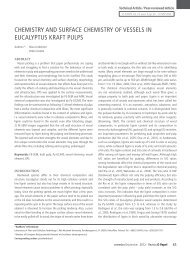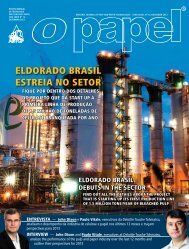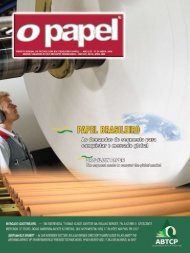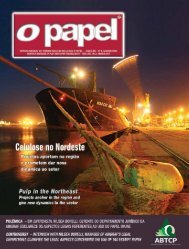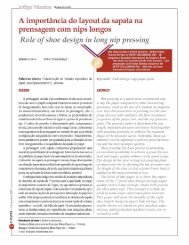Nova publicação - Revista O Papel
Nova publicação - Revista O Papel
Nova publicação - Revista O Papel
Create successful ePaper yourself
Turn your PDF publications into a flip-book with our unique Google optimized e-Paper software.
cessing capacity of 370 m 3 of solid wood<br />
per hour. Alone, the new line 4 can process<br />
305 m 3 of solid eucalyptus with bark<br />
per hour. “The new equipment allows obtaining<br />
much more uniform chips, which<br />
results in higher yield in the digester, and<br />
consequently better pulp quality”, says<br />
Canhisares.<br />
In the open-type chip storage it is<br />
possible to see, from afar, a big circular<br />
pile. From the top, a constant “rain”<br />
of small particles of wood accurately<br />
moulds the pile, which may go as far<br />
as to contain 43 thousand m³. Movable<br />
arms of the equipment on the floor reclaim<br />
the chips, as explains the executive,<br />
and a belt conveyor running under<br />
the equipment takes this raw material<br />
directly to the mill. The stacker reclaimer<br />
model now in use at Klabin Monte Alegre<br />
allows the Fifo (first in, first out) practice,<br />
which allows the first chips arriving<br />
at the storage area to be also the first<br />
ones to follow to fibre production, keeping<br />
the stock continually renewed.<br />
The new machine<br />
The bold targets of Klabin, which<br />
in 2003 had undergone a restructuration<br />
and announced that it would reach<br />
a production of 2 million tons of papers<br />
per year, were the great drivers for the<br />
MA-1100 Project to become a reality.<br />
The big star of the expansion is precisely<br />
the PM9, designed to be the most modern<br />
paperboard machine of the world, capable<br />
of producing Folding Box Board,<br />
Carrier Board, and LPB (Liquid Packaging<br />
Board), the latter used in manufacturing<br />
long-life packaging for liquid<br />
and pasty food. “Klabin perceived that<br />
the market was developing and foresaw<br />
that at a certain moment the production<br />
capacity of its PM7 would not be able to<br />
match demands”, reports Braga.<br />
The new machine, supplied by Voith,<br />
designed to produce multilayer paper,<br />
was inspired by PM7, also in operation<br />
at the Monte Alegre mill. “PM7 is 30<br />
years old. It started producing kraftliner,<br />
later going over to producing cartonboards.<br />
It has undergone a series of<br />
rebuilds during all these years, Klabin<br />
having developed its knowledge on it”,<br />
he explains. For this very reason, it has<br />
been reference for the new machine, of<br />
similar design, but with a totally new<br />
generation of auxiliary equipments and<br />
control systems.<br />
The stock preparation section is traditional.<br />
PM9 produces three-layer board.<br />
For this purpose it is equipped with three<br />
headboxes and three wire-formers, while<br />
PM7 has only two headboxes and two<br />
wire-formers. “In the new equipment,<br />
each layer has its own wire-former, which<br />
has the purpose of improving web formation,<br />
as it is at this moment that the fibres<br />
get their structure. We think that this is the<br />
best design for our grade of papercarton”,<br />
says Braga. The top layer of the paper is<br />
white, made from bleached pulp, while the<br />
bottom one is made from softwood pulp<br />
with kappa 80. As to the intermediate layer,<br />
it is made from a fibre mixture, with the<br />
lowest possible cost but with the required<br />
stiffness. The composition of this intermediate<br />
layer has been developed over the<br />
course of many years and, as Canhisares<br />
explained previously, the CTMP technology<br />
is also a feature of this project.<br />
The press section is practically the<br />
same as that already running on PM7,<br />
with two shoe presses and one smoothing<br />
press. PM7 has one shoe press and one<br />
suction press. “An uncommon feature at<br />
this section is using a smoothing press,<br />
but here it is intended for the first sheet<br />
surface treatment, on the top layer of the<br />
paper”, explains Braga.<br />
Drying is carried out in the traditional<br />
way, with 64 dryer cylinders. For<br />
finishing purposes, a steel rolls - hard<br />
nips - calender stack was installed. “This<br />
is also something we learned with PM7,<br />
as on it we had already used a soft roll<br />
calender stack, and observed that the<br />
hard metal rolls yield a better result for<br />
the web profile.” After this calender<br />
stack, the coater section has three applicators.<br />
The first one applies a coating<br />
layer on the top and a starch covering on<br />
the bottom. After this stage, the second<br />
applicator forms a new coating layer<br />
only, by means of a combined blade-jet<br />
applicator. In the final section of the<br />
coater, a third coating layer is applied on<br />
the white surface. “The purpose of this<br />
whole procedure is to improve printability<br />
of the final packaging.”<br />
According to the manager, the major<br />
modification on the machine was made<br />
in the web forming section, by going<br />
over to using three wire-formers, but<br />
the machine also relies on a completely<br />
new generation of auxiliary equipments,<br />
having a more efficient sheet tail transfer<br />
system, in addition to more effective tools<br />
for the operation assistance and control,<br />
such as a break monitoring system.<br />
Besides the three grades of board,<br />
PM9 can also manufacture kraftliner,<br />
since there is a market maturation time<br />
to absorb the 350 thousand tons of paperboard<br />
that can be produced per year<br />
on this equipment.<br />
By Franklin Xavier / Klabin<br />
O PAPEL - Fevereiro 2009<br />
35


